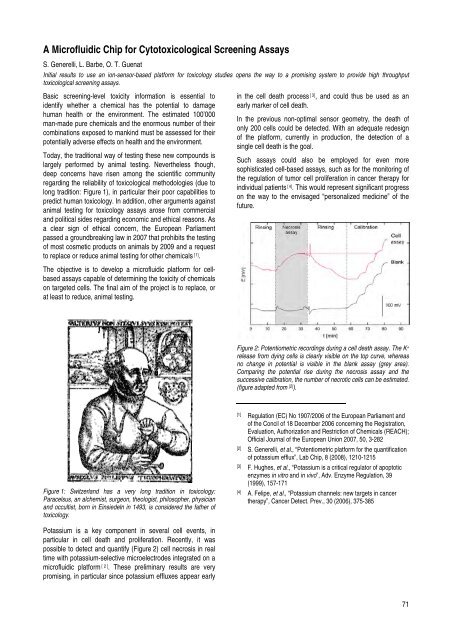CSEM Scientific and Technical Report 2008
CSEM Scientific and Technical Report 2008
CSEM Scientific and Technical Report 2008
Create successful ePaper yourself
Turn your PDF publications into a flip-book with our unique Google optimized e-Paper software.
A Microfluidic Chip for Cytotoxicological Screening Assays<br />
S. Generelli, L. Barbe, O. T. Guenat<br />
Initial results to use an ion-sensor-based platform for toxicology studies opens the way to a promising system to provide high throughput<br />
toxicological screening assays.<br />
Basic screening-level toxicity information is essential to<br />
identify whether a chemical has the potential to damage<br />
human health or the environment. The estimated 100’000<br />
man-made pure chemicals <strong>and</strong> the enormous number of their<br />
combinations exposed to mankind must be assessed for their<br />
potentially adverse effects on health <strong>and</strong> the environment.<br />
Today, the traditional way of testing these new compounds is<br />
largely performed by animal testing. Nevertheless though,<br />
deep concerns have risen among the scientific community<br />
regarding the reliability of toxicological methodologies (due to<br />
long tradition: Figure 1), in particular their poor capabilities to<br />
predict human toxicology. In addition, other arguments against<br />
animal testing for toxicology assays arose from commercial<br />
<strong>and</strong> political sides regarding economic <strong>and</strong> ethical reasons. As<br />
a clear sign of ethical concern, the European Parliament<br />
passed a groundbreaking law in 2007 that prohibits the testing<br />
of most cosmetic products on animals by 2009 <strong>and</strong> a request<br />
to replace or reduce animal testing for other chemicals [1] .<br />
The objective is to develop a microfluidic platform for cellbased<br />
assays capable of determining the toxicity of chemicals<br />
on targeted cells. The final aim of the project is to replace, or<br />
at least to reduce, animal testing.<br />
Figure 1: Switzerl<strong>and</strong> has a very long tradition in toxicology:<br />
Paracelsus, an alchemist, surgeon, theologist, philosopher, physician<br />
<strong>and</strong> occultist, born in Einsiedeln in 1493, is considered the father of<br />
toxicology.<br />
Potassium is a key component in several cell events, in<br />
particular in cell death <strong>and</strong> proliferation. Recently, it was<br />
possible to detect <strong>and</strong> quantify (Figure 2) cell necrosis in real<br />
time with potassium-selective microelectrodes integrated on a<br />
microfluidic platform [ 2] . These preliminary results are very<br />
promising, in particular since potassium effluxes appear early<br />
in the cell death process [ 3] , <strong>and</strong> could thus be used as an<br />
early marker of cell death.<br />
In the previous non-optimal sensor geometry, the death of<br />
only 200 cells could be detected. With an adequate redesign<br />
of the platform, currently in production, the detection of a<br />
single cell death is the goal.<br />
Such assays could also be employed for even more<br />
sophisticated cell-based assays, such as for the monitoring of<br />
the regulation of tumor cell proliferation in cancer therapy for<br />
individual patients [4] . This would represent significant progress<br />
on the way to the envisaged “personalized medicine” of the<br />
future.<br />
Figure 2: Potentiometric recordings during a cell death assay. The K +<br />
release from dying cells is clearly visible on the top curve, whereas<br />
no change in potential is visible in the blank assay (grey area).<br />
Comparing the potential rise during the necrosis assay <strong>and</strong> the<br />
successive calibration, the number of necrotic cells can be estimated.<br />
(figure adapted from [2] ).<br />
[1] Regulation (EC) No 1907/2006 of the European Parliament <strong>and</strong><br />
of the Concil of 18 December 2006 concerning the Registration,<br />
Evaluation, Authorization <strong>and</strong> Restriction of Chemicals (REACH);<br />
Official Journal of the European Union 2007, 50, 3-282<br />
[2] S. Generelli, et al., “Potentiometric platform for the quantification<br />
of potassium efflux”, Lab Chip, 8 (<strong>2008</strong>), 1210-1215<br />
[3] F. Hughes, et al., “Potassium is a critical regulator of apoptotic<br />
enzymes in vitro <strong>and</strong> in vivo”, Adv. Enzyme Regulation, 39<br />
(1999), 157-171<br />
[4] A. Felipe, et al., “Potassium channels: new targets in cancer<br />
therapy”, Cancer Detect. Prev., 30 (2006), 375-385<br />
71








